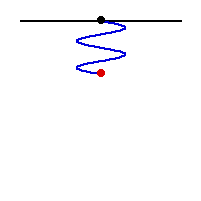The Bungee Jumper: Conservation of Energy
Obj: Determine the distance a bungee
person falls based on the determined k of a spring
Materials: spring, bungee person, meter stick, weights
Procedures
and Analysis
Calculate the slope of the line (=spring constant k).
mgΔh = ½kh2 which simplifies to: mg = ½kh
Now, call over the physics instructor for the next step.
7. Attach the bungee person to the spring
and support the person such that the spring is at the no-load (unstretched) position.
Raise the bungee person to the appropriate height (h). Consider the body length of the bungee
person.
Grade:
bungee person hits table (a fatality) = 1, within 8-10 cm of table = 3,
within 4-7 cm = 4, less than 4 cm = 5
Back to the Brockport High School Science Department